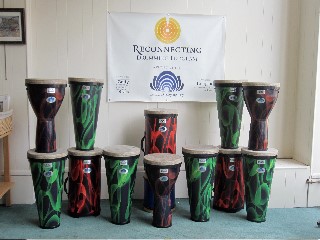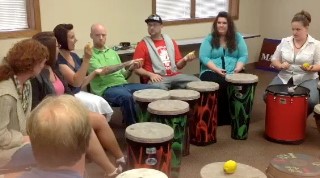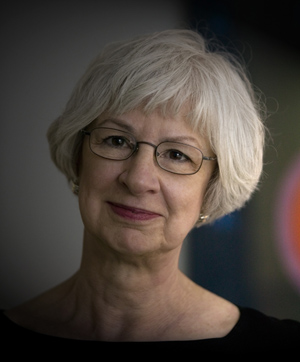Special Reports
Central Ohio Symphony's Drumming Circle
 Orchestra teams with the local courts to help troubled teens
Orchestra teams with the local courts to help troubled teens
Creating community outside the concert hall has become a priority for American orchestras of all sizes, even those with tiny budgets and minimal staff. Take the Central Ohio Symphony: With a budget of $275,000, there’s little left once its 65 professional musicians are paid for the five-concert season.
 Based in Delaware, OH, a city of about 35,000 north of Columbus, COS was founded in 1978 as a volunteer community group and successor to the Ohio Wesleyan University Symphony. With its 670 annual subscribers, and with Delaware a fairly well-heeled area, COS’s primary community service in the past has been its free July 4th concerts, which this year drew an estimated 8,000. But executive director and timpanist Warren W. Hyer, a lifelong percussionist who joined the orchestra before it turned professional in 1990, was looking for something deeper.
Based in Delaware, OH, a city of about 35,000 north of Columbus, COS was founded in 1978 as a volunteer community group and successor to the Ohio Wesleyan University Symphony. With its 670 annual subscribers, and with Delaware a fairly well-heeled area, COS’s primary community service in the past has been its free July 4th concerts, which this year drew an estimated 8,000. But executive director and timpanist Warren W. Hyer, a lifelong percussionist who joined the orchestra before it turned professional in 1990, was looking for something deeper. Social justice meets the percussive arts
In the late 2000s, he and his wife, April Nelson, now a retired attorney, began working with local judges to help set up courts attuned to individuals with addiction and mental-health problems. Crime isn’t a massive issue in Delaware, but a steady stream of young people with those issues goes through the local courts each year—about 60 are currently on court probation.
 Attending the annual Percussive Arts Society convention in 2010, in Indianapolis, the couple decided to sign up for workshops on therapeutic drum circles—a kind of therapy designed to help troubled people recognize and express emotions that may be blocking their recovery. Research has found that, through some mysterious physical and psychological alchemy, wailing away on a drum or shaking a rattle helps many people find the words and inner resources they need to deal with their problems.
Attending the annual Percussive Arts Society convention in 2010, in Indianapolis, the couple decided to sign up for workshops on therapeutic drum circles—a kind of therapy designed to help troubled people recognize and express emotions that may be blocking their recovery. Research has found that, through some mysterious physical and psychological alchemy, wailing away on a drum or shaking a rattle helps many people find the words and inner resources they need to deal with their problems.Nelson and Hyer quickly realized that drum circles would be a good fit for Delaware’s specialized courts; local officials agreed to give them a try, not only for therapeutic reasons, but also as a way to keep offenders in regular contact with the court system.
Just one problem. “We didn’t have any equipment and we had no money,” says Hyer.
Finding the funds, launching the program
Over the next two years, the COS concentrated on fund raising; a $16,000 grant for each of three consecutive years from Ann and Gordon Getty Foundation Community Investment helped provide seed money for supplies and training. The second grant essentially launched the program in Spring 2013 and COS is anticipating a third to finance next year. With the Getty grants, Hyer has bought instruments, now totaling 30 big drums along with tambourines, shakers, and small hand drums.
The grants also paid for training for Hyer and two associates: COS percussionist Caitie Thompson and Rhonda Milner, a supervising therapist at a mental health and addiction facility in Columbus.
 Launching the program in spring of 2013, Hyer, Thompson, and Milner now run a year-round series of drum circles for between 15 to 20 adults and a varying number of teens and their families. Young participants can range from as few as two to as many as 10 per session, as they cycle in and out of the program. Teens come to two per month, one for teens alone, the other for teens and their families.
Launching the program in spring of 2013, Hyer, Thompson, and Milner now run a year-round series of drum circles for between 15 to 20 adults and a varying number of teens and their families. Young participants can range from as few as two to as many as 10 per session, as they cycle in and out of the program. Teens come to two per month, one for teens alone, the other for teens and their families.Test the waters, exploit the anger
After only one year of operation, it’s difficult to meaningfully assess the program. Lynne Schoenling, a Juvenile Treatment Court magistrate in Delaware, thinks the ratio so far is 50-50, with as many participants being helped as those who fall back into destructive patterns. “It’s a coin flip,” she says. “But a coin flip is better than 10 percent.”
Milner, Hyer, and Thompson can cite specific incidents where youngsters and adults are communicating verbally in ways that were impossible before the drum sessions.
Thompson remembers one such episode with a teen who was struggling with anger and resentment toward his father.
“We said, ‘Play what your anger feels like.’ He said, ‘I can’t do that, I’ll break the drum.’ Warren and I looked at each other, and we said, ‘Break it.’ He took the mallets and went to town on that drum. The look on his face after he finished was complete relief. It was like he had just let out all of these emotions he had been holding back because he didn’t have any place to let go of them.”
The drum, she added, didn’t break.

Wynne Delacoma is a freelance arts writer, lecturer, and critic whose outlets include the Chicago Sun-Times, Chicago Classical Review, and MusicalAmerica.com. Classical music critic for the Chicago Sun-Times from 1991 to 2006, she has been an adjunct faculty member at Columbia College Chicago and Northwestern University’s Medill School of Journalism.





 FEATURED JOBS
FEATURED JOBS

 RENT A PHOTO
RENT A PHOTO


